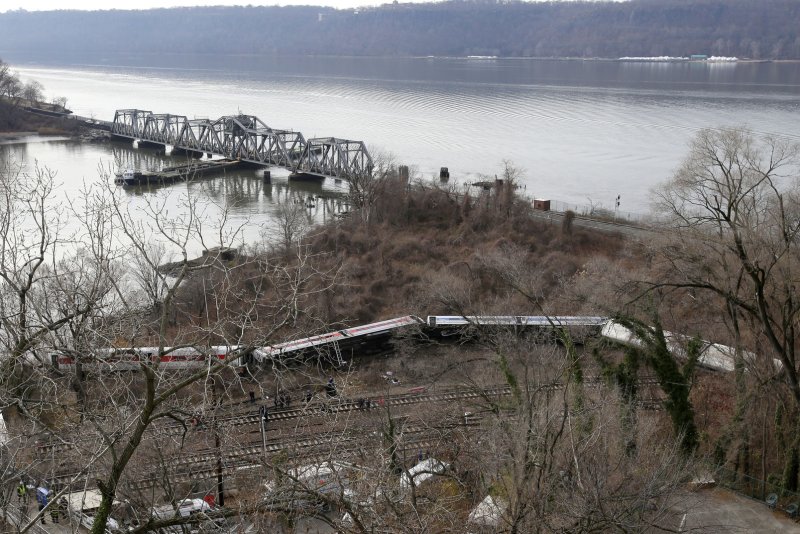1 of 7 | Police on the scene investigate around a Metro-North Train after it derailed on route to Grand Central Station in New York City on December 1, 2013. At least four people were killed and 63 injured after the Metro-North passenger train derailed on a sharp curve in the Bronx borough of New York City on Sunday morning. UPI/John Angelillo |
License Photo
NEW YORK, Dec. 2 (UPI) -- The commuter train that derailed in New York and killed four people was going 82 mph when it hit a curve where the speed limit is 30 mph, officials said Monday.
National Transportation Safety Board member Earl Weener said the train's throttle was engaged until 6 seconds before the locomotive came to a stop and the brakes were applied 5 seconds before the seven-car Metro-North train derailed in the Bronx Sunday morning, NBC News reported.
"The question is: Was this human error or faulty equipment?" Weener said. "And the answer is at this point in time we can't tell."
He said, the train was traveling well more than the posted 70 mph speed limit before it rounded one of the sharpest curves on the line and derailed. Of the 63 people injured, at least 19 remained hospitalized, NBC News said.
The data came from an examination of two black-box recorders recovered from the train after it jumped the tracks Sunday morning.
"When I heard about the speed, I gulped. It kind of takes your breath away," said Sen. Charles Schumer, D-N.Y., who said it would be "premature" to draw any conclusions about the cause of the excessive speed.
Train engineer Bill Rockefeller, who was hospitalized with minor injuries, told first responders at the scene he applied the brakes as the train approached the curve.
Also Monday NTSB investigators found a second data recorder in the wreckage.
Weener said NTSB would be at the site for a week to 10 days, USA Today reported.
Early Monday, workers began returning the seven cars to their upright position to the extent that safety officials would allow, a spokesman for the railroad told CNN.
New York Gov. Andrew Cuomo, who has visited the scene, said Monday he thinks speed will figure into the derailment.
"I'm not an expert in this field, working with the experts over the -- over the past day, I think, it is gonna be speed-related," Cuomo said.
He said the curve has been on the line "for decades" and trains negotiated it "all day long."
"So it's not about the turn," Cuomo said. "I think it's gonna turn out to be about the speed more than anything, and the operator's operation of the train at that time."
It wasn't clear how fast the train was traveling Sunday, but a Metropolitan Transportation Authority official told The New York Times the engineer told emergency personnel he "dumped the brakes" when he realized he was going into the curve too quickly. Even though he executed the emergency procedure and the train somewhat slowed, it still derailed.
The Federal Railroad Administration, which enforces rail safety regulations, is also investigating the accident.















